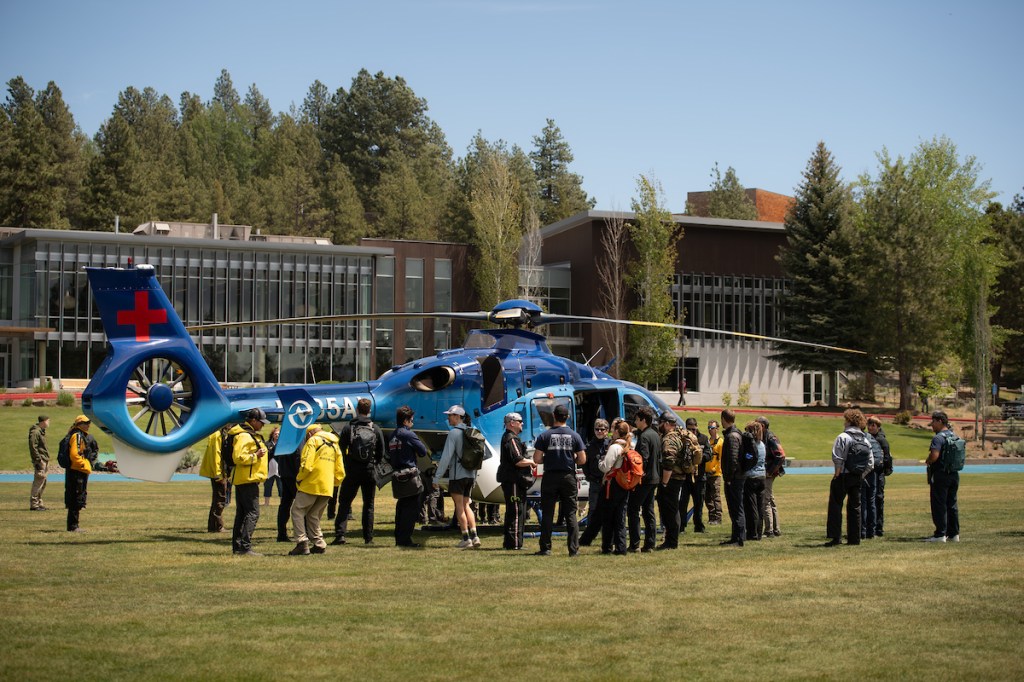Sponsored Content
Becoming a Paramedic
Published 11:59 am Monday, November 11, 2024
By MARK RUSSELL JOHNSON
Clustered around an ambulance stretcher and gently working to intubate a motionless young boy — a rubbery simulation manikin, actually, wearing brightly patterned pajama bottoms — a group of four paramedic students in a Central Oregon Community College (COCC) lab is putting their training to the test. The lifesaving measure, which involves using a slanted device to insert a breathing tube, requires the students to peer down the throat and sight the vocal cords, sliding the tube in between and down into the patient’s airway.
They take turns intubating, verbalizing their movements. Teammates watch and offer support. Leaning in and trying to find the perfect touch, all look the part, wearing gray polo shirts, dark pants and work boots — a program requirement that puts students in the workplace headspace. Two other teams attend to their own “patients” under the watchful eye of instructors.
Looking on, Rod VanOrsdol likes what he sees. As a retired assistant fire chief from Sarasota County in Florida — who spent 35 years in the emergency medical services (EMS) profession as a firefighter/paramedic, flight medic and SWAT team member — VanOrsdol, the program’s lead instructor, has seen plenty. He brings a career’s worth of experience, but also knows the field is rapidly evolving these days. Paramedics now provide more care than ever before, going well beyond stabilizing and transporting — the COCC training reflects that.
“The list of medications a paramedic needs to know has gone from 30 to 45, and will soon be 50,” says VanOrsdol, pointing to new research as the reason. An abundance of studies on out-of-hospital care, he explains, has brought new understandings about what should comprise this vital tier of emergency care. His students will spend an entire term, for instance, focused on cardiac care. “We hit the ground running. Their first day, they’re responsible for knowing six chapters of material.”
The rigorous, accredited two-year Paramedicine program at COCC includes a one-year EMT certificate (offered in Bend and Redmond, the latter a night-class program) that builds foundational skills such as CPR, patient assessment, therapeutic communication and initial management of medical and trauma emergencies. Paramedics then undergo a deep dive into how the body’s systems are impacted by diseases and trauma, and how to minimize damage. They learn to administer medications, start intravenous lines and interpret heartbeat variations.
For those considering becoming a firefighter in Oregon, it’s necessary to be an EMT also. At COCC, this means obtaining a two-year Associate of Applied Science Fire Science degree. For EMS careers outside the fire service, COCC also offers an Associate of Applied Science EMS degree. Because both degrees require EMT certification, many students opt for adding one year of Paramedicine training to their Fire Science studies, for a total of three years and two standalone degrees. Throughout, the aim is to wrap competence with confidence.
“I remember feeling, without a doubt, that the faculty and staff would help me get through to the end of my time there,” says recent graduate Natalie Dickson, now a firefighter-paramedic with Gresham Fire and Emergency Services. “Time and time again, I was blown away by how easy it was to reach out anytime I had a question or problem. They weren’t just advisers, they were truly my cheerleaders.”

Realistic emergency scenarios are the standard. Simulators include a mock passenger car that allows for windshield and door extractions, while a classroom-based ambulance interior, dubbed “The Office,” gives students an accurate space to practice on-scene and in-transit skills — guidance comes from nearby instructors, looking on via a camera feed. With the classroom lights off and the ambulance lights on, the setting can mimic a chaotic nighttime call.
The program also has a fully operational ambulance for vehicle operations practice and a relationship with AirLink periodically brings a helicopter to the Bend campus’s athletic field to provide Q&A moments with flight medic crews. Students get to practice skills on manikins that can mimic human breathing, work IV needles into simulated arms, and staff will heighten realism by adding props such as fake blood, plastic chainsaws and other details.
One of the core experiences of the programs is the clinical component, where paramedic students engage in rotations at St. Charles Health System, spending hands-on supervised time in the family birthing unit, emergency departments, pediatric department and operating rooms. “We’ve worked closely with COCC for around 50 years to provide comprehensive clinical experiences,” says Janice Pendroy, a clinical practice and professional development specialist at St. Charles.
In all, students will spend between 600 to 800 hours in clinical and field settings, including the immersive summer internship. For Logan Noble, whose Salem-based internship required him to utilize his Spanish language skills and also work among an extensive homeless population, it was “the most valuable experience that I received from my time as a paramedic student.”
The goal of the weeks-long co-op work experience, or “CWE,” is for the student to be able to safely execute all the trauma skills and medical treatments normally rendered by a paramedic, with oversight from an experienced paramedic preceptor. “I would hop on an ambulance with my preceptor and his partner for 12 hours a day and learned how to work in one of the busiest 911 systems in the Pacific Northwest,” he says.
New paramedics are finding their skills in demand, in part because COVID-caused burnout has diminished the front-line workforce. In addition to more traditional work environments like emergency clinics and ambulance services, graduates might work on oil rigs, cruise ships or mobile health care units with the national certification they earn at COCC. Recent grads are finding jobs locally, VanOrsdo says, but have also landed in distant places, from Alaska to South Carolina. “Paramedics can ‘write their own ticket’ these days,” he says.
Find out more about the challenging and fulfilling life of a paramedic by visiting cocc.edu/programs/ems.






